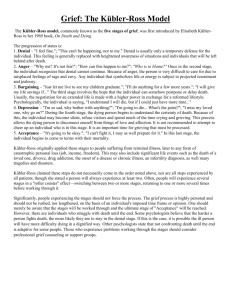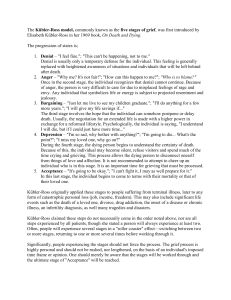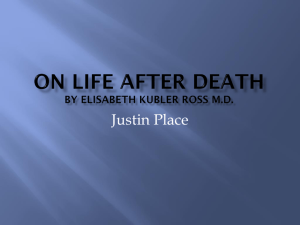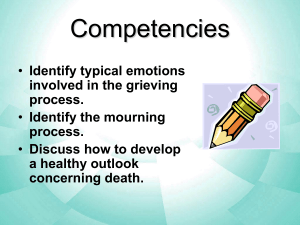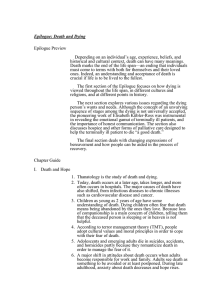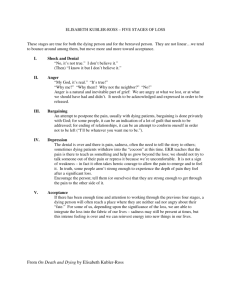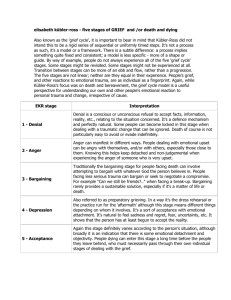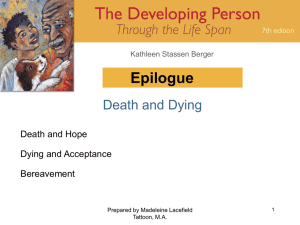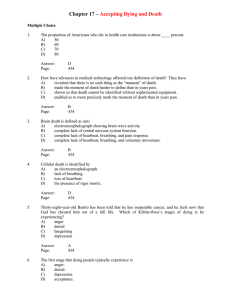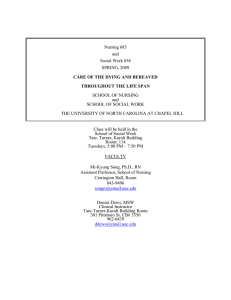Chapter 1 - FacultyWeb
advertisement
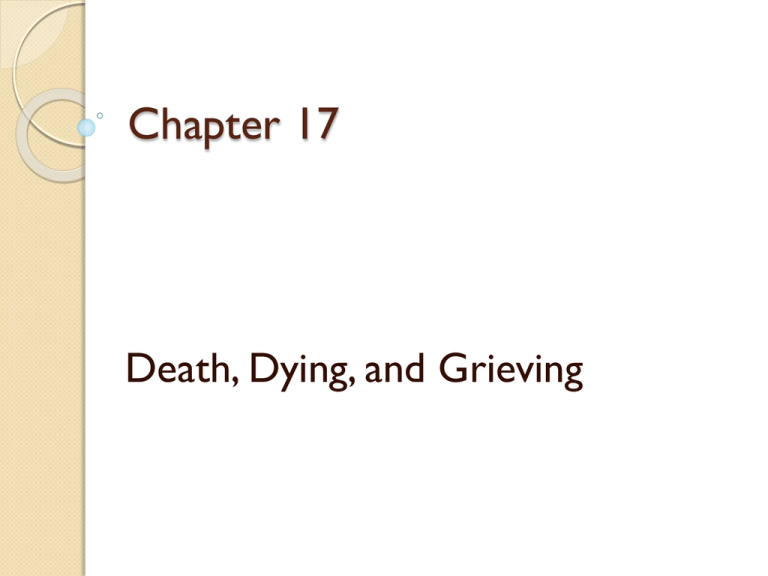
Chapter 17 Death, Dying, and Grieving Defining Death In the past several decades, defining death has become more complex Brain death -- the neurological definition, when all electrical activity of the brain has ceased for a specified period ◦ individual whose higher cortical areas have died may continue breathing and have a heartbeat Natural Death Act and Advance Directive Living will -- document filed while the individual can still think clearly, which expresses the person’s desires regarding extraordinary medical procedures that may or may not be used to sustain life ◦ advance directive All 50 states now accept advance directives as reflecting an individual’s wishes Euthanasia Euthanasia -- painlessly ending lives of individuals who are suffering from an incurable disease or severe disability ◦ mercy killing ◦ two types: active -- when death is deliberately induced assisted suicide passive -- when a person is allowed to die by withholding available treatment Needed: Better Care for Dying Individuals End-of-life care should include respect for the goals, preferences, and choices of the patient and his or her family ◦ Hospice -- program committed to making the end of life as free from pain, anxiety, and depression as possible ◦ Palliative care -- reducing pain and suffering and helping individuals die with dignity Changing Historical Circumstances 200 years ago, many children and young adults died ◦ average life expectancy was 47 years In 1900, most people died at home, cared for by family Today, death occurs most often among older adults ◦ average life expectancy has increased to 78 80 percent of deaths occur in institutions and hospitals with professional caregivers Cultural Variations Individuals are more conscious of death in times of war, famine, and plague Most societies have had philosophical or religious beliefs about death and most have a ritual that deals with death In most societies, death is not viewed as the end of existence; the spirit is believed to live on Kübler-Ross’ Stages of Dying Five stages ◦ ◦ ◦ ◦ ◦ denial and isolation anger bargaining depression acceptance (Kübler-Ross, 1969) Evaluation of Kübler-Ross 5-stage sequence has not been supported by research findings Stages did not account for individual circumstances of patient and support systems However, she did much to call attention to the issues of quality of life and coping with dying (Kastenbaum, 2007) Coping with Death and Loss It is best for dying persons and their family members to know that death is immanent and a reality ◦ individuals can close life with their own ideas about proper dying ◦ they can complete some projects and plans and can make arrangements for funeral and for survivors ◦ can reminisce ◦ can experience physical sensations and medical procedures (Banja, 2005; Kalish, 1981) Effective Strategies for Communicating with a Dying Person Establish presence at same eye level and don’t be afraid to touch the dying person Eliminate distraction, including excessive small talk Keep visits short with frail individuals Don’t prescribe or deny feelings of acceptance Allow and encourage expressions of feelings Effective Strategies for Communicating with a Dying Person Ask the person what the expected outcome of the illness is; discuss alternatives and unfinished business Ask if there is anyone he or she would like to see or have someone contact Encourage the dying person to reminiscence Talk to the individual when he or she wishes to talk Express your regard for the dying individual, don’t be afraid to express love Dimensions of Grieving Grief -- emotional numbness, disbelief, separation anxiety, despair, sadness, and loneliness that accompany the loss of someone we love Many dimensions ◦ ◦ ◦ ◦ pining or yearning separation anxiety despair and sadness hopelessness and defeat Dimensions of Grieving Prolonged Grief – Grief that involves enduring despair and is still unresolved over an extended period of time Disenfranchised grief describes an individual’s grief over a deceased person that is a socially ambiguous loss that can’t be openly mourned or supported ◦ Ex-spouse ◦ Abortion Coping and Type of Death Impact of death is strongly influenced by circumstances under which death occurs Sudden, untimely, violent, or traumatic deaths are likely to have more intense and prolonged effects Diverse grieving patterns are culturally embedded practices Making Sense of the World One beneficial aspect of grieving is that it stimulates many individuals to try to make sense of the world When death is caused by accident or disaster, the effort to make sense of it is pursued vigorously Bereaved want to put death in a perspective they can understand Losing a Life Partner Those left behind by an intimate partner often prefer to suffer profound grief and often endure financial loss, loneliness, increased physical illness, and psychological disorders Many widowers increase religious and spiritual beliefs following the loss of a spouse Many widows are lonely Bereaved are at higher risk for health problems Social support helps them adjust to the death of a spouse Forms of Mourning One decision is to decide what to do with the body ◦ burial ◦ cremation Funeral services ◦ more meaningful to religious survivors Family and community have important roles
